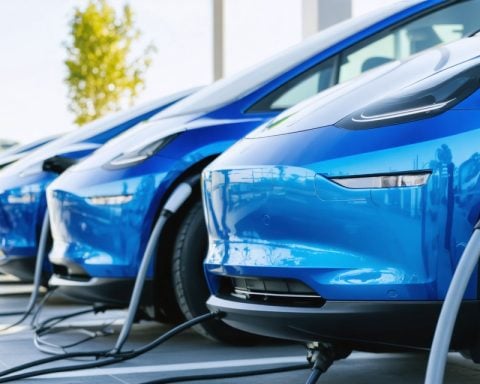- The Federal Highway Administration has ordered a halt to the rollout of electric vehicle (EV) infrastructure under the National Electric Vehicle Infrastructure (NEVI) program.
- This sudden decision stems from a shift in federal policy, aiming to modify NEVI’s plans, causing confusion among state transportation officials.
- NEVI, part of the 2021 Bipartisan Infrastructure Law, pledged a $5 billion federal fund for a network of fast-charging stations.
- The suspension of EV projects threatens to dampen enthusiasm for electric vehicles, exacerbating range anxiety among potential buyers.
- States, like Vermont, face disrupted plans and stalled projects, highlighting the impact of regulatory changes on infrastructure development.
- The situation underlines how regulatory shifts can influence policy, infrastructure progress, and consumer confidence in sustainable transportation.
A sudden halt has gripped the nation’s electric vehicle charging ambitions. A directive from the Federal Highway Administration recently stunned state transportation officials, freezing the rollout of electric vehicle (EV) infrastructure under the ambitious National Electric Vehicle Infrastructure (NEVI) program. Born from the 2021 Bipartisan Infrastructure Law, NEVI promised a sprawling network of fast-charging stations, fueled by a $5 billion federal fund covering most costs.
Chaos unfurls as officials grapple with this unexpected order, delivered not through the usual legislative process but rather by memo. This abrupt standstill threatens to dampen the growing enthusiasm for electric vehicles, as range anxiety continues to be a key concern for eco-minded drivers eyeing the road ahead.
The decision rides on recent shifts in federal policy. The administration seeks to shake up the blueprint for NEVI, requiring states to halt new projects until fresh guidance emerges. Transport departments in varying stages of progress now find themselves caught in a web of confusion and hold back the green light for future plans.
In a telling example, Vermont’s Agency of Transportation has stalled its initiatives, leaving 11 projects to gather dust and idling a network that should be expansive. This disruption could have broader implications, as data suggests a meager installation of charging stations despite massive allocations.
The key takeaway: regulatory shifts ripple through policy landscapes, affecting not only state decision-makers but also trickling down to affect consumer confidence in a greener automotive future. As states navigate this uncertain terrain, the race continues to bridge the gap between ambitious federal goals and tangible, on-the-ground infrastructure.
Electric Vehicle Charging Plans on Hold: What You Need to Know and How It Impacts You
Overview: The Impact of the Federal Directive
The freeze on the National Electric Vehicle Infrastructure (NEVI) program, due to a sudden directive from the Federal Highway Administration, represents a significant setback for the development of electric vehicle (EV) infrastructure across the United States. This directive has created confusion among state transportation departments and has potential repercussions for consumer confidence and the broader goals of reducing carbon emissions.
How-To Steps & Life Hacks for Navigating the EV Charging Halts
– Monitor Local Developments: Stay informed about the progress of state-specific EV infrastructure initiatives. States are gathering feedback and preparing for new guidelines; tune into transportation department announcements.
– Identify Alternative Charging Solutions: For EV owners concerned with charging availability, explore home charging setups or locate existing public chargers with apps like PlugShare or ChargePoint.
– Plan Trips with Charging in Mind: Utilize trip planners that incorporate EV charging locations, which can help mitigate range anxiety during travel.
Real-World Use Cases & Implications
– Impact on Commutes: For daily commuters depending on public fast-charging, the delay means either adjusting routes to incorporate fewer, possibly busier stations, or reconsidering charging locations altogether.
– Business Travel Considerations: Companies operating EV fleets need to assess impacts, potentially reimbursing employees for new charging stops or exploring fleet home charging solutions.
Market Forecasts & Industry Trends
Despite the current halt, the global EV market continues to grow. According to the International Energy Agency (IEA), EV adoption is expected to keep accelerating, with global sales set to rise from 10 million units in 2021 to a forecasted 25 million by 2030. Infrastructure rollout delays may prompt innovations in portable or temporary charging solutions.
Reviews & Comparisons: Charging Networks
– Tesla Supercharger: Known for speed and reliability, limited to Tesla models unless adapters are available.
– Electrify America: Offers fast charging for various models but sometimes criticized for higher costs and equipment reliability.
– EVgo and ChargePoint: Provide extensive networks, with ChargePoint leading in flexibility and adaptability for different vehicle models.
Controversies & Limitations
The memo-driven halt bypasses more conventional legislative mechanisms, sparking a debate on transparency and procedural fairness. This disruption emphasizes the challenge of aligning federal policies with state-level execution capabilities.
Features, Specs & Pricing of Charging Equipment
Modern charging stations vary:
– Level 2 Chargers: Typically deliver 25 miles of range per hour, costing around $500-$2,000 for home installation.
– DC Fast Chargers: Much faster, providing 60-80 miles in 20 minutes, but require significant infrastructure and investment.
Security & Sustainability
A delay in infrastructure development could slow progress in reducing emissions and meeting climate goals. However, as more renewable sources power electric grids, the long-term sustainability of EVs remains promising.
Insights & Predictions
Experts predict an eventual re-launch of federal support for EV infrastructure with updated guidelines emphasizing technological advancements and public-private partnerships. As states adjust to new directives, they could provide crucial learnings for future large-scale federal projects.
Tutorials & Compatibility
Compatibility with charging stations is crucial. Owners of non-Tesla EVs should ensure their vehicles adapt to different connectors like CCS or CHAdeMO to avoid charging issues.
Pros & Cons Overview
Pros:
– Potential for a more cohesive and updated strategy once the NEVI program resumes.
– States have an opportunity to revise plans for efficiency and innovation.
Cons:
– Current halt delays immediate rollout, impacting consumer and business operations.
– Uncertainty may slow EV adoption or affect consumer confidence.
Actionable Recommendations
– Prepare Home Charging Solutions: As a safeguard, install home chargers if feasible to reduce reliance on public infrastructure.
– Engage with Local Advocacy Groups: Advocate for quicker resolution and more robust infrastructure development.
– Talk to Dealers: When purchasing a new EV, discuss charging solutions and future-proofing strategies.
For more information and continued updates, visit Federal Highway Administration and The U.S. Department of Energy. These sites regularly publish news on energy and infrastructure initiatives, offering reliable resources to keep abreast of developments in the EV sector.













